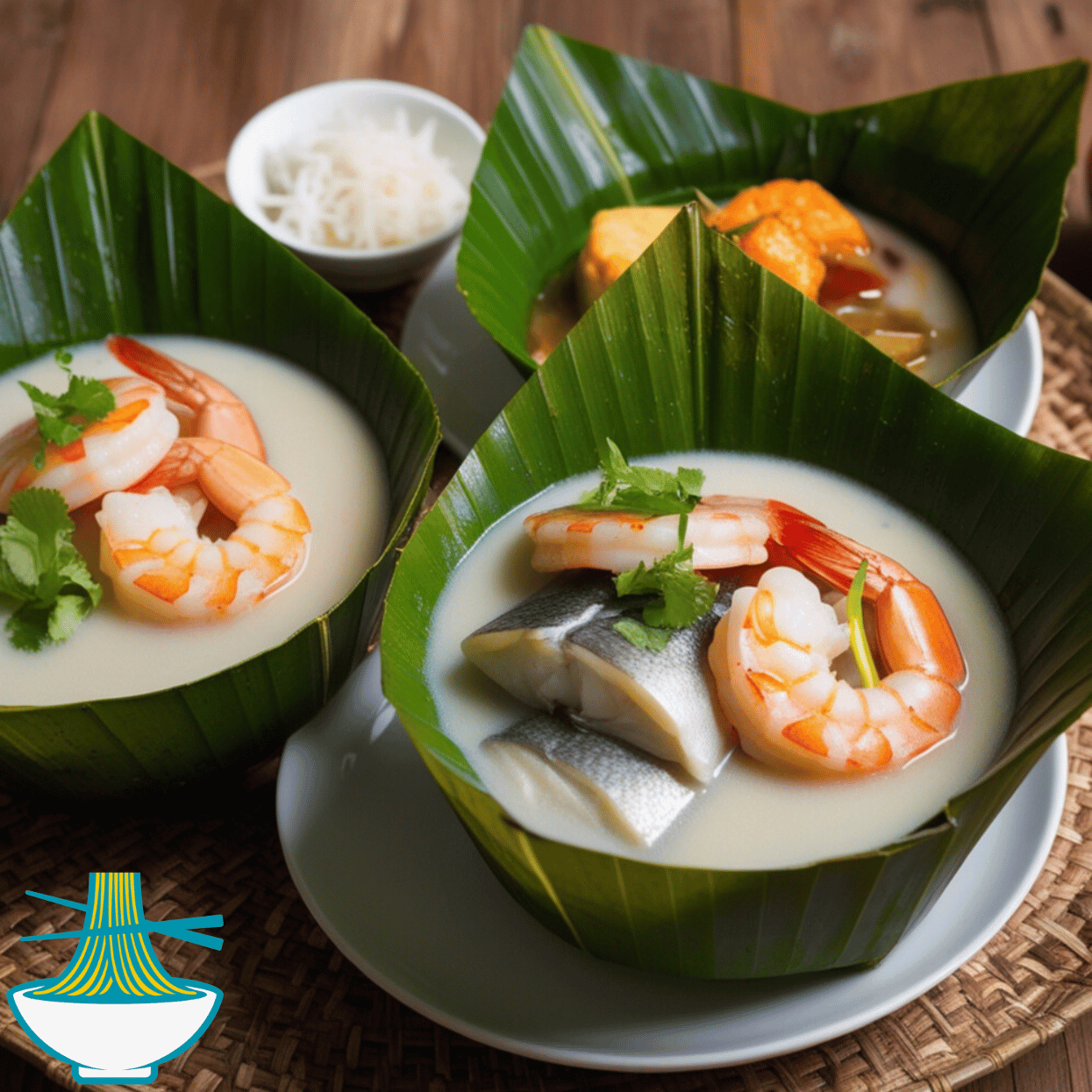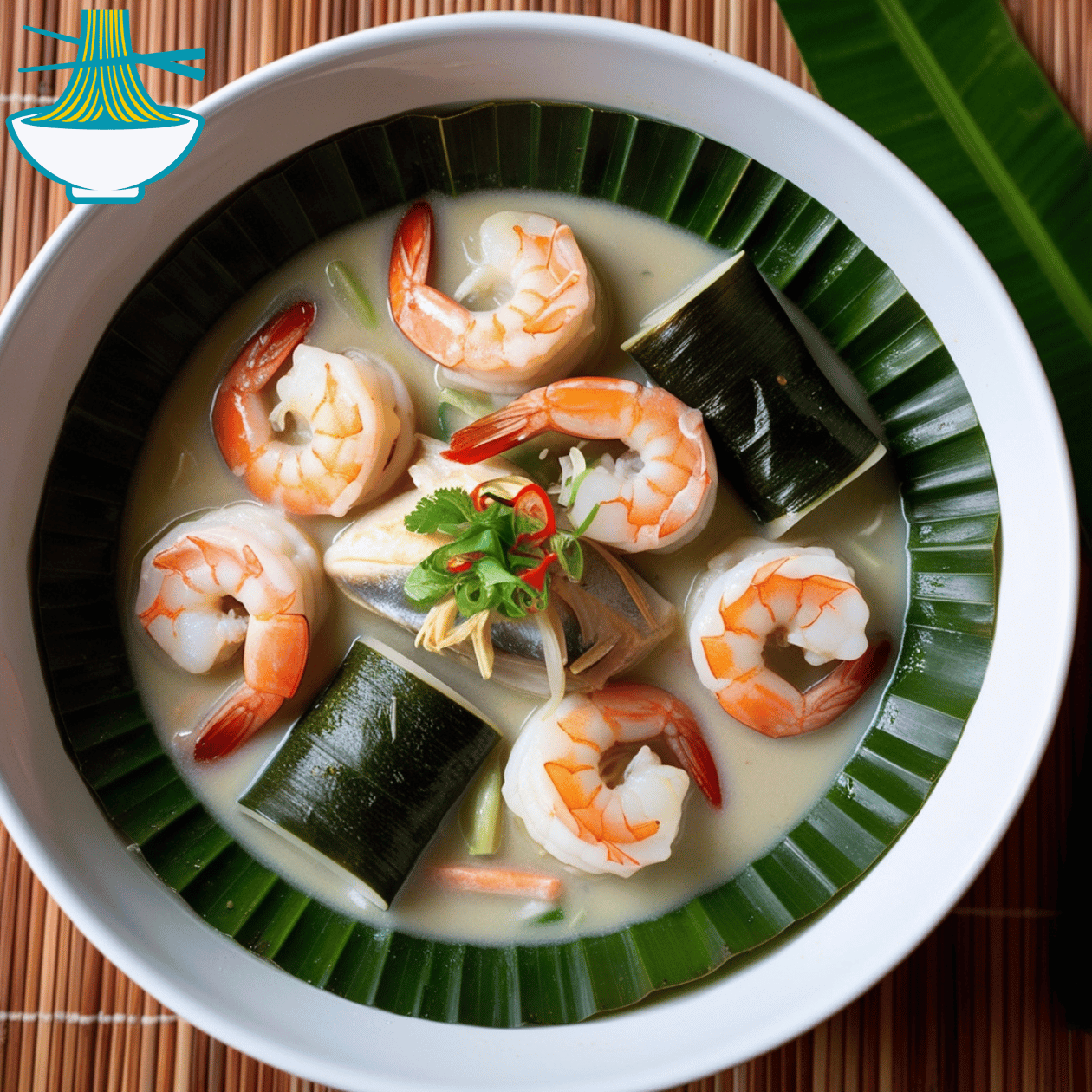Cambodian Amok is a traditional dish from Cambodia, known for its aromatic, creamy, and flavorful profile. Typically made with fish, it can also be prepared with chicken, shrimp, or vegetables. Amok is steamed and served in banana leaf cups, which enhance its presentation and taste. The dish combines rich coconut milk, fragrant spices, and tender fish, making it a standout in Cambodian cuisine.
Amok dates back to the Khmer Empire (9th to 15th centuries) and was originally created in the royal kitchens for special occasions. The name "Amok" comes from the Khmer word meaning "to wrap" or "to steam in banana leaves," a tradition that adds aroma and visual appeal. Over time, Amok spread from the royal court to become a staple in Cambodian households, symbolizing the country's rich culinary heritage. The dish is also linked to the folktale of Preah Thaong and Neang Neak, highlighting its cultural significance. Today, Cambodian Amok is enjoyed in restaurants and street food stalls across Cambodia.
Ingredients:
- Fish fillets (cod or tilapia)
- Kroeung (Cambodian spice paste)
- Coconut milk
- Fish sauce
- Sugar
- Turmeric powder
- Kaffir lime leaves
- Red chili peppers
- Banana leaves

Instructions:
1. Prepare Ingredients:
- Cut fish fillets into bite-sized pieces.
- Make the kroeung paste by blending lemongrass, galangal, garlic, shallots, turmeric, and kaffir lime zest into a smooth paste.
2. Create Amok Sauce:
- Heat oil in a saucepan, add kroeung paste, and stir-fry until fragrant.
- Add coconut milk, fish sauce, and sugar. Stir to combine.
3. Steam the Amok:
- Add fish fillets to the sauce, stir gently to coat.
- Add kaffir lime leaves and red chili peppers.
- Cover and steam over medium heat for 10-15 minutes until the fish is tender.
4. Prepare Banana Leaf Cups:
- Cut banana leaves into squares. Pass over an open flame to soften.
- Fold into cup shapes, securing with toothpicks or string.
5. Serve:
- Remove toothpicks or string from banana leaf cups.
- Fill with steamed fish and sauce.
- Garnish with kaffir lime leaves and sliced red chili peppers.
Nutritional Benefits:
Cambodian Amok offers several health benefits:
- Fish: Rich in omega-3 fatty acids, which support heart health.
- Coconut Milk: Provides healthy fats and a creamy texture.
- Spices: Include turmeric and kaffir lime leaves, known for their anti-inflammatory and digestive benefits.
Enjoy the flavorful and nourishing Cambodian Amok, a true reflection of Cambodia's rich culinary heritage!

Nutrition Value:
1. Fish fillets (cod or tilapia)
- Calories: Low in calories, around 70-90 calories per 100 grams
- Carbohydrates: Minimal, about 0 grams per 100 grams
- Protein: High in protein, approximately 15-20 grams per 100 grams
- Fat: Low in fat, around 1-2 grams per 100 grams
- Sodium: Low sodium, around 50-60 mg per 100 grams
- Cholesterol: Moderate cholesterol, about 40-50 mg per 100 grams
- Vitamins: Rich in vitamin B12, important for red blood cell formation and neurological function
- Minerals: Good source of selenium, which supports antioxidant defense and thyroid function
- Nutritional Benefit: Provides high-quality protein and essential nutrients with low fat and calories, supporting muscle health and overall well-being
2. Kroeung (Cambodian spice paste)
- Calories: Variable depending on ingredients, typically around 30-60 calories per 2 tablespoons
- Carbohydrates: Low to moderate, about 3-6 grams per 2 tablespoons
- Protein: Minimal, less than 1 gram per 2 tablespoons
- Fat: Low, around 2-4 grams per 2 tablespoons
- Sodium: Variable, generally around 200-300 mg per 2 tablespoons
- Cholesterol: No cholesterol
- Vitamins: Contains vitamins from herbs used, such as vitamin C from lemongrass
- Minerals: Provides some minerals from spices like turmeric and garlic
- Nutritional Benefit: Adds flavor and antioxidants to dishes, can support digestive health and reduce inflammation
3. Coconut milk
- Calories: Approximately 450-500 calories per 1 cup
- Carbohydrates: About 6-8 grams per 1 cup
- Protein: Around 5 grams per 1 cup
- Fat: High in fat, about 45 grams per 1 cup
- Sodium: Around 30-60 mg per 1 cup
- Cholesterol: No cholesterol
- Vitamins: Contains some vitamin C and vitamin E
- Minerals: Good source of manganese and magnesium
- Nutritional Benefit: Rich in healthy fats and provides a creamy texture, supports heart health, and adds essential nutrients
4. Fish sauce
- Calories: Approximately 10 calories per tablespoon
- Carbohydrates: About 1 gram per tablespoon
- Protein: Minimal, less than 1 gram per tablespoon
- Fat: Negligible fat
- Sodium: High in sodium, around 1,000-1,200 mg per tablespoon
- Cholesterol: No cholesterol
- Vitamins: Minimal vitamins
- Minerals: Contains some minerals like calcium
- Nutritional Benefit: Adds umami flavor to dishes, but high sodium content should be monitored for individuals with high blood pressure
5. Sugar
- Calories: About 16 calories per teaspoon
- Carbohydrates: 4 grams per teaspoon
- Protein: None
- Fat: None
- Sodium: None
- Cholesterol: None
- Vitamins: None
- Minerals: None
- Nutritional Benefit: Provides energy through simple carbohydrates but should be consumed in moderation to avoid excess calorie intake
6. Turmeric powder
- Calories: Approximately 24 calories per tablespoon
- Carbohydrates: About 4 grams per tablespoon
- Protein: Around 0.5 grams per tablespoon
- Fat: About 0.7 grams per tablespoon
- Sodium: Minimal, around 1 mg per tablespoon
- Cholesterol: No cholesterol
- Vitamins: Contains some vitamin C
- Minerals: Good source of iron and manganese
- Nutritional Benefit: Contains curcumin, which has anti-inflammatory and antioxidant properties, supporting overall health and reducing inflammation
7. Kaffir lime leaves
- Calories: Very low, around 5 calories per leaf
- Carbohydrates: Minimal, less than 1 gram per leaf
- Protein: Minimal, less than 1 gram per leaf
- Fat: Negligible fat
- Sodium: Very low, about 1-2 mg per leaf
- Cholesterol: No cholesterol
- Vitamins: Contains some vitamin C
- Minerals: Provides small amounts of calcium and potassium
- Nutritional Benefit: Adds unique flavor and aroma, provides antioxidants and vitamins that can support immune function
8. Red chili peppers
- Calories: Approximately 18 calories per 100 grams
- Carbohydrates: About 4 grams per 100 grams
- Protein: Around 1 gram per 100 grams
- Fat: Minimal fat, less than 0.5 grams per 100 grams
- Sodium: Very low, around 2 mg per 100 grams
- Cholesterol: No cholesterol
- Vitamins: Rich in vitamin C and vitamin A
- Minerals: Contains potassium and iron
- Nutritional Benefit: Provides antioxidants like capsaicin, which may boost metabolism and support cardiovascular health
9. Banana leaves
- Calories: Very low, negligible
- Carbohydrates: Minimal, less than 1 gram per leaf
- Protein: Minimal
- Fat: Negligible
- Sodium: Very low
- Cholesterol: No cholesterol
- Vitamins: Contains small amounts of vitamins A and C
- Minerals: Contains calcium and iron
- Nutritional Benefit: Primarily used for wrapping and flavoring food, contributing minimal nutrients but enhancing presentation and aroma



Comments